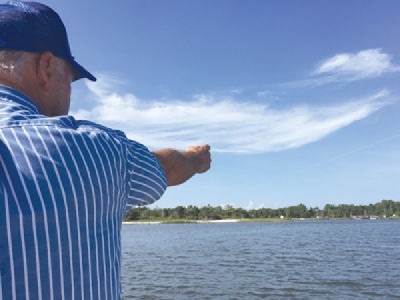
Posted on August 2, 2016
By Jackie Starkey, Carolina Coast Online Home
Under the sun-drenched, unassuming waters just past Cedar Island, time has spread the sands from low-lying bodies and nesting islands into the sea, clogging the arteries of cardinal waterways traversed by the quiet fishing communities of Down East.
Now, longtime Commissioner Jonathan Robinson helms the charge for county-led maintenance of the channel at Wainwright Slough, at the north end of Core Sound, to relieve what he has declared emergency conditions.
The passage, which connects the Pamlico and Core sounds, is well used by commercial fishermen to access bountiful waters, but significant shoaling along the path has made both launching and landing seafood-laden vessels essentially impossible, according to area fishermen.
“Inclement weather washed an island into the channel here, and it happens all the time,” Bradley Styron, owner and operator of Quality Seafood, said from a small boat trimming its way through shallow waters Monday.
Wainwright Slough has an authorized depth of 7 feet, according to the U.S. Army Corps of Engineers, but the disintegration of small banks and larger land masses have significantly contributed to shoaling.
Only the shallowest of boats can now traverse the most critically hampered portions of Wainwright, where depth drops as low as 1 foot in some stretches.
“It’s like if you live at the end of a dirt road and they cut off your access to the highway,” Mr. Robinson said as he surveyed the conditions. “This here is a killer of our fishermen and our way of life.”
Those able to traverse Wainwright Slough to deeper waters are often forced to land their catch elsewhere due to the shallow water, according to Mr. Styron.
“When they’re light they can pick their way through,” he noted, “but you get 3,000, 5,000 pounds of shrimp and you can’t make it.”
Instead they’re paying to land elsewhere, oftentimes out of the county.
“We don’t have the luxury of places like Emerald Isle and Pine Knoll Shores, that have the sand tax, to meet our needs,” Mr. Styron said.
Instead the unincorporated Down East fishing communities rely on county and state maintenance of their infrastructure – including the waterways.
The shoaling in Wainwright Slough also cuts off the opportunity afforded by several harbors accessible by the channel, including Atlantic Harbor of Refuge.
“I feel for this (problem) because I know how significant it is,” said Mr. Robinson, a former commercial fisherman turned state legislator.
Call to action
While residents here say the slough has not been properly addressed in about 20 years, the county did receive $1 million in Hurricane Sandy relief funds in mid-2013 to perform some work along the east end of Taylor’s Creek and Wainwright Slough.
In recent months, conditions have led Mr. Robinson to be outspoken in seeking relief for Wainwright, prompting the county to ask for an emergency dredge.
“The Corps said ‘no, we can’t let you do that as an emergency option,’ ” Shore Protection Manager Gregory “Rudi” Rudolph told the News-Times last week. However, the Corps did survey Wainwright Slough at the end of June, producing an updated report on conditions there.
Mr. Rudolph confirmed the county is looking to other options, specifically a pipeline dredge to remove about 25,000 cubic yards of material from Wainwright under the Corps’ authorizations.
He could give no projected cost of the work though, of which the county will pay 1/3 of the total cost while the state’s shallow draft navigation fund pays out the rest.
Officials await more information from the Corps before sending the project out to bid, including whether they can re-route Wainwright Slough through deeper water and move less material, and what can be done to correct the erosion of the disposal island there, possibly a costly leg of the project.
Whatever the cost, the money would come from the county’s general fund if the project is approved.
Campaigning begins
The critical conditions at Wainwright are a prime example of why county voters should support November’s referendum to increase the local option sales tax to accumulate revenues for dredging, Mr. Robinson said last week.
“I spent 45 years out here (on the water) on a pretty regular basis. I want to help the eastern end of the county,” he said.
Mr. Styron, who serves on both the County Harbor Authority and on the county’s new waterways management committee, agreed.
“They think they’re not getting anything out of it,” Mr. Styron said of critics of the tax, “but it’s improving the quality of life for everybody. … The only way to have access to fresh local seafood is a strong commercial presence here.”
If voters approve the referendum on the Nov. 8 ballot, the local sales tax will increase a quarter-cent from 6.75 to 7 cents, with the funds set aside for inland waterway maintenance projects.
While the county has touted a majority of the annually expected $2.5-2.6 million in revenues would be paid by tourists, many lament an additional tax burden on the county’s fulltime residents, specifically those who are not boaters.
Additionally, county commissioners cannot secure the money solely for dredging into the future, though they have said they would like to store it separately from other funds for transparency.
The board has unanimously voiced support of the referendum since its failure in 2014, moving it onto the General Election ballot earlier this month.
Mr. Robinson said he will campaign for the increase this fall no matter its likelihood of passing. In the meantime, however, he’s turned his eyes to Wainwright Slough, hoping his good standing as the public servant of those Down East will bring some dredging relief here.
“You’d like to think you’re making a difference for people,” he said Monday. “I’d like to see this get done.”
Source: Carolina Coast Online Home





